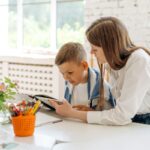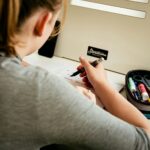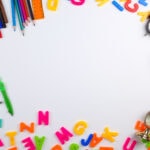Getting your child excited about science and increasing their interest in learning something new is much easier than it may seem. One of the most successful methods is learning through games. Combining the initial knowledge of subjects and hiding this information inside an exciting game or experiment will be much easier to achieve than the child himself loved to learn, and in the future, with joy to learn new skills and acquire knowledge.
Just imagine that you are a college paper writing service writer, and you have been tasked with writing about the best science experiments for children. Using the information from this article and supplementing it with your own ideas will give you an excellent presentation for the child, plus that will be fun for the whole family. Further, we will tell you how to turn your home into a real mini laboratory, offer ideas for simple and complex experiments, and give advice on space safety and organization. After all, everyone knows that the best fun is safe fun.
Preparing Your Home Lab
To make everything even more exciting, you can get white coats and dress up in a place with children who are natural scientists. And that everything you need was immediately at hand and the experiments took place in a safe and controlled space, you must make some preparations.
Necessary Materials and Tools
To conduct scientific experiments, you will need such materials and tools:
- Plastic and glass containers
- Measuring cups and spoons
- Lab gloves and goggles
- Baking soda, vinegar, salt
- Batteries, wires with terminals
Most of this list may be in your pantry or kitchen, and what is missing can be easily purchased at the grocery store and electrical supply stores.
Basic Safety Tips
All the experiments we will discuss are safe, but it is still worth guarding against the unexpected.
- Make sure you have safety glasses and gloves for you and the children working in the makeshift
- Make sure the children understand the safety rules. ( no touching wires, putting anything in their mouths, scratching their eyes, or picking up anything without permission or with their bare hands).
- Keep all dangerous objects close to you and only allow children to use them under your supervision.
It is best also to give safety instructions playfully. Tell the children you are playing a laboratory game, and all the rules are the same as in real work. Make them feel important and responsible for their actions.
Organizing the Experiment Space
Choose a place where you will conduct the experiments. It can be the kitchen, living room, garage, or backyard. It is best to have access to running water and a ventilated and well-lit space.
Simple Experiments for Toddlers
Let’s start with exciting experiments for toddlers. These experiments will help them understand basic scientific principles through play and hands-on activities.
Baking soda and vinegar volcano
Materials needed:
- Baking soda
- Vinegar
- Plastic bottle
- Paints or dye
Conducting the experiment
Pour baking soda into the bottle up to half of it, add the dye, and then pour vinegar in little by little. A chemical reaction of carbon dioxide will start, and the baking soda will foam up and simulate an eruption. If you want more colorful, you can make papier-mâché mountains and the neck of the bottle to make a crater. Explain to the children what happened. This experiment is perfect for sensitizing children to chemistry.
Layers of liquid
Materials needed:
- Water
- Vegetable oil
- Honey
- Transparent glass or jar
Experiment
Pour honey on the bottom of the jar, wait until it spreads an even layer, then carefully add water, and when its surface calms down, carefully pour vegetable oil on the tip of a spoon or knife. This experiment shows children that different liquids have different densities and can be arranged in layers.
Experiments for Schoolchildren
These experiments require more preparation as they are a little more complicated.
Growing crystals
Materials needed:
- Water
- Salt
- Jar or beaker
- Thread and pencil
Conducting the experiment
Dissolve as much salt as possible in a glass of water. Sprinkle it in gradually to control the process. After that, boil the liquid. Wrap a string around a pencil, place the pencil across the beaker so that the string is in the liquid, put the glass in a quiet place, and watch the formation of crystals. When the liquid cools down, the excess salt crystals are attached to the thread and form the likeness of stones of natural origin.
Pocket rainbow
Materials needed:
- Glass prism or beaker
- Flashlight
Experimenting:
Place the glass on a flat surface, point a beam of light at it, and watch a small rainbow form. Explain to the children that even though the glass appears completely transparent, light rays are refracted on its surface to form a multi-colored glow.
Electrolysis of water
Materials needed
- Battery
- Wires with clamps
- Two graphite rods (e.g., from pencils)
- Water
- Baking soda
- Glass jar
Experimenting:
Fill the jar with water and add baking soda. You should also connect the graphite rods and batteries using wires with clips. Then, lower the graphite into the water and watch the formation of bubbles. Electrolysis releases hydrogen and oxygen from the water. This experiment shows children the basics of electricity and chemistry.
Tips for Engaging Children in Science
Games and experiments will be most effective. Feel free to use online resources to find new ideas for science games or experiments that can be done at home. It is also crucial to encourage children to do their own investigations in a safe environment and show interest in their progress. This works best when the child sees you are proud of them and enjoy their progress.
Conclusion
Home science experiments are a great way to turn a game into something more. Such experiments ignite children’s interest in science and develop a curious mind and critical thinking. By turning the home into a laboratory, parents can help their children learn the basics of science and develop useful skills. Start with simple experiments and gradually increase the complexity of the tasks to keep children interested and motivated to explore science. This educational process and a fun pastime can bring the whole family closer together.








